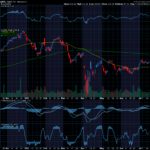by Lee Gettess
One of the questions that always amuses me when I talk about potential entries with other traders is “Well, does it work?” My answer usually involves asking them to define “work”. An entry is only as good as the exit that accompanies it; and different exits can drastically change the performance of any given entry technique.
While thinking this over, however, I came up with somewhat of a standard to begin measuring how well something “works”. That is, can you take profits that at least equal the risk you are taking? If you buy T-Bonds at 109-16 and your stop is 109-05, can you take profits at 109-27? If you can get your profit to equal your risk, you just have to be right more than 50% of the time and you will make money.
Of course, if your profits are twice as big as your risk, then you can be right less often and still make money. Using this framework, I have developed a money management plan that suits this entry technique quite well. There is room for a little bit of judgment if you desire, or you can simply decide to follow one or more of the potential exits in a mechanical fashion.
It is extremely helpful for money management purposes to trade at least two contracts and preferably three. You may not be able to, based on your account size and the risk involved. However, if you can afford to trade multiple contracts, it gives you an advantage. Here is how: measure the distance from your entry point to your stop loss point. Add that distance to your entry. That is your initial target. You exit one of your contracts at that point, then pull your stop up on the remaining contracts so that the entire trade will not be a loser. If you are trading two contracts, you are at breakeven, even if you don’t move your stop.

Once the market moves in your favor (so that you have twice the profit as the original risk), take your second contract off and move your stop on the remaining contract to your original entry point. If you are only trading two contracts you may wish to trail your stop rather than exiting at two times risk. You will find that you will reach the profit-equals-risk target better than 60% of the time. Markets differ slightly, both from market to market and time frame to time frame, but that is a pretty accurate guideline. Generally speaking, the longer the time frame you can trade the more reliable the signals will be.
So, take one off when the open profit equals the original risk. Take a second off when it reaches a profit that is twice the original risk. Then trail the stops on the third. You can trail stops behind swing highs and lows on the market you are trading, or use our measurement of risk and trail two levels behind. That is, if we have reached two times the risk as a profit, you pull your stop to the original entry. If you reach three times risk, move your stop to protect profits equal to the original risk. At four times risk, you protect two times risk, etc. You will find that the probabilities start to drop off once you have achieved profits equal to five times the original risk.
Certainly there are times when the markets trend extremely hard and go ten times risk or greater, but not very often. Once you have achieved five times risk you should either simply exit at that point, or at least move your stop much closer.
I want to emphasize that risk control is probably the most important aspect of your trading. It is the only area that you really do maintain control over, for the most part. While there is no perfect amount for you to risk, it is imperative that you only risk what you are comfortable with. Losses are an inevitable part of trading, and if you allow them to either totally deplete your capital, or worse yet – damage you psychologically, you will not be around to execute good trades to bring you the profits.











Recent Comments